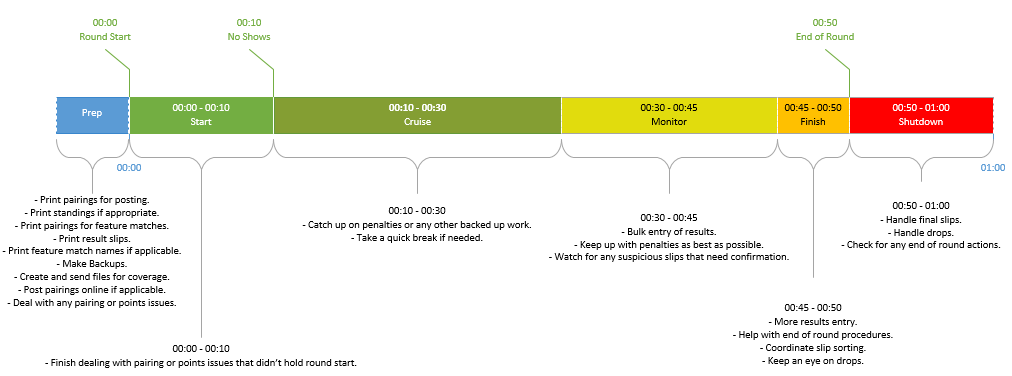Every tournament has a pulse, and every round has a heartbeat. That heartbeat is much like your own – it can change a little, speed up, slow down, more blood, less blood. Sometimes there’s even a palpitation to keep things interesting. But at the end of the day, it’s the same action, again and again.
Understand that heartbeat, and you understand how to help a tournament run smoothly. 90% of what you need to know to get it right lives in this chart (click for full size):
This chart is the heartbeat. It consists of the six distinct phases to every tournament round.
1) Prep – The previous round is done, let’s get the next one started by getting everyone into the right seat. The round needs to be paired, players need to figure out where they’re playing, and they need to get to those seats.
2) Start – Shuffle and present. Players begin play. Tardiness penalties for late players apply. Deck checks happen. Any problems with pairings due to mistaken pairings or other problems need to be corrected. Hopefully this is settled by the time we reach the No Show/Match Loss threshold, after which everyone is playing happily and we can …
3) Cruise – Play Magic. Handle Rulings.
4) Monitor – We’re entering the home stretch, and a lot of playing is starting to finish and results are getting reported and thus a lot of data entry is happening. Help keep the area clear so things stay efficient. Also, though Slow Play is always an issue, this is the phase at which it starts to crop up more frequently as players consciously or unconsciously start to watch the time left in the round.
5) Finish – Time to get the round closed out. At this point it becomes practical to make sure that we have coverage of matches that are still going.
6) Shutdown – We’re into extra turns now, do what needs to be done to get this round finished. If you can’t concretely help with this, everyone benefits best if you get off your feet and out of the way.
Don’t understand? Let’s take a look at a concrete example. Let’s take your average paper team member. Note that this is a generic version, as always, make sure you are in sync with your head judge and/or team lead about the specifics for any given tournament:
Or perhaps, more mysterious to the judge at large, how life looks for the scorekeeper:
Ignoring one-off tournament-level activities (for example, put out the draft sets in preparation for a draft – more on this in a future post), this is all you need to have an effective day. Figure out your chart, write it down if you need, and follow it. Rinse and repeat.
The experienced judges have this committed to muscle memory at this point, and it shows. It is no accident that when we need somebody to handle something, John Alderfer’s name comes up a lot (to pick a concrete example, though he certainly isn’t the only one). He, and others of his ilk, are uncannily frequently in the right place at the right time. This is not coincidence – somewhere down the line, he internalized this timeline and he follows it, round in and round out.
The less experienced or less well-considered judges don’t have this instinct yet, and that also shows. The super-experienced judges know their own pulses as well as those of everyone else, and they weave that understanding together to be maximally helpful to the things that others need to do. After all, staffing is a team exercise.
Find your role. Figure out your chart. Follow it. Someday, it will be instinct and you won’t need to codify it. Until then, fake it until you make it. Any senior judge should be able to help you fill yours out.



Nick, thanks for writing this. It’s highly educational to see things from a scorekeeper’s viewpoint and a fun read.
I’m looking forward to more posts.